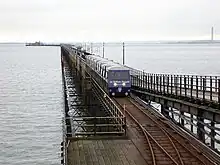3 ft gauge railways in the United Kingdom
A list of 3 ft (914 mm) narrow-gauge railways in the United Kingdom.
| By transport mode | ||||||||||||||||||||||||||||||||||||||||||||||||||||||||||||||||||||||||||||||||||||||||||||||||||||||||||||||||
|---|---|---|---|---|---|---|---|---|---|---|---|---|---|---|---|---|---|---|---|---|---|---|---|---|---|---|---|---|---|---|---|---|---|---|---|---|---|---|---|---|---|---|---|---|---|---|---|---|---|---|---|---|---|---|---|---|---|---|---|---|---|---|---|---|---|---|---|---|---|---|---|---|---|---|---|---|---|---|---|---|---|---|---|---|---|---|---|---|---|---|---|---|---|---|---|---|---|---|---|---|---|---|---|---|---|---|---|---|---|---|---|---|
| By size (list) | ||||||||||||||||||||||||||||||||||||||||||||||||||||||||||||||||||||||||||||||||||||||||||||||||||||||||||||||||
| ||||||||||||||||||||||||||||||||||||||||||||||||||||||||||||||||||||||||||||||||||||||||||||||||||||||||||||||||
| Change of gauge | ||||||||||||||||||||||||||||||||||||||||||||||||||||||||||||||||||||||||||||||||||||||||||||||||||||||||||||||||
| By location | ||||||||||||||||||||||||||||||||||||||||||||||||||||||||||||||||||||||||||||||||||||||||||||||||||||||||||||||||
 | ||||||||||||||||||||||||||||||||||||||||||||||||||||||||||||||||||||||||||||||||||||||||||||||||||||||||||||||||


The worldwide usage of locomotives on railways, including 3 ft (914 mm) gauge railways, has its origins in the United Kingdom in the early 19th century during the Industrial Revolution. In fact, in 1802, a 3 ft gauge plateway-type railway owned by the Coalbrookdale Company in England became the first railway in the world to have a locomotive designed and built for it. The locomotive's designer, Richard Trevithick, is credited with making the first recorded successful demonstration of a locomotive on rails (in 1804 on a different railway in Wales). 3 ft gauge locomotive-powered railways, along with other narrow-gauge railways of varying widths, would later become one of the most common railway gauges chosen for short-distance lines in the British Isles, such as those found in mines and industrial sites (see table below).
Railways
| Country/territory | Railway |
|---|---|
| England |
|
| Northern Ireland | |
| Scotland |
|
| Wales |
|
See also
References
- Tonks, Eric (1992). The Ironstone Quarries of the Midlands Part 9: Leicestershire. Cheltenham: Runpast Publishing. ISBN 1-870-754-085.
- Quine, Dan (2016). Four East Midlands Ironstone Tramways Part Two: Kettering. Vol. 106. Garndolbenmaen: Narrow Gauge and Industrial Railway Modelling Review.
